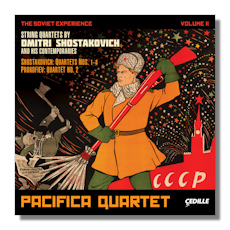
The Internet's Premier Classical Music Source
Related Links
-
Prokofieff Reviews
Shostakovich Reviews - Latest Reviews
- More Reviews
-
By Composer
-
Collections
DVD & Blu-ray
Books
Concert Reviews
Articles/Interviews
Software
Audio
Search Amazon
Recommended Links
Site News
 CD Review
CD Review
The Soviet Experience

String Quartets by Dmitri Shostakovich
and his Contemporaries, Volume II
- Dmitri Shostakovich:
- String Quartet #1 in C Major, Op. 49
- String Quartet #2 in A Major, Op. 68
- String Quartet #3 in F Major, Op. 73
- String Quartet #4 in D Major, Op. 83
- Serge Prokofieff:
- String Quartet #2 in F Major, Op. 92
Pacifica Quartet
Cedille CDR90000130 2CDs 75+54min
As his admirers are aware, Shostakovich wrote fifteen quartets, the same number as his symphonies. Yet, he wrote his first quartet only after he had written the first five symphonies. Later in his career, Shostakovich turned to the quartet form more often, especially as writing large scale works became more difficult because of the gradual debilitation in his right hand from polio, which was diagnosed in 1965. Matching the decline in his health was the dark character of his later quartets: #15 is arguably his most death-obsessed work and consists of six consecutive Adagio movements, all of them bleak and despairing.
His early quartets, however, are relatively hopeful works – for Shostakovich, anyway. The First Quartet contains much the same direct expressive language as its contemporary sibling, the Fifth Symphony. In fact, all four of these quartets, while exhibiting more than a few harrowing moments (No. 2, in particular), are generally less dominated by a sense of angst or gloom, ingredients so essential and seemingly ubiquitous in later Shostakovich quartets. That said, I wouldn't call the early quartets happy works either, just less pessimistic ones.
The Pacifica Quartet (Simin Ganatra & Sibbi Bernhardsson, violins; Masumi Per Rostad, viola; Brandon Vamos, cello) play all these works with spirit, impressive technical skill, and a genuine sense for Shostakovich's manic-depressive mood swings and mixture of humor and sarcasm. In fact, they seem to concede nothing, either interpretively or technically, to their competition in these works, and that competition is formidable. Try as one example the finale of the Second Quartet, where the group's intensity is shattering as the music seems to scream before settling into a subdued but defiant ending. Their overwhelming vehemence and sense of foreboding in third movement of the Third Quartet are chilling, while sending chills up your spine. This is playing of the highest order! I can go on: they penetrate these works with a keen grasp of the music's emotional and stylistic flow, making it easy, for example, to hear a kinship between the Fourth Quartet's second movement and the Fifth Symphony's third movement, or the Fourth Quartet's third movement and the sprightly first movement of the Second Piano Concerto.
The Beethoven and Borodin Quartets have historically been associated with the Shostakovich quartets and rightly so, as their performances of them have become benchmarks of sorts. While these two Soviet ensembles were championing Shostakovich's quartets in the early years, the Fitzwilliam Quartet and Emerson Quartet went on to make fine recorded cycles of the fifteen quartets. And there have been many groups who have turned in impressive cycles of these works as well. It would be hard to crown a winner in this repertory, but the Pacifica Quartet would certainly be a major contender. I now regret that I missed the first issue in this cycle, which contained Quartets Nos. 5, 6, 7 & 8, along with the Miaskovsky Quartet #13. It's Cedille's idea to issue the Pacifica's Shostakovich cycle with other Soviet works from the mid-20th century.
Here the coupling is the very excellent Prokofiev Quartet #2, a work in which the composer uses Kabardinian melodies, sourced in the Northwest Caucuses, where Prokofiev and other composers stayed for much of the Second World War. The Second is a bright, optimistic work, with a lovely central movement that offers a mesmerizing theme. The Pacifica's account clearly evidences this ensemble's ability to seamlessly move from Shostakovich's darker, lonelier world to Prokofiev's brighter and more melodically appealing realm.
The Pacifica players deftly capture the rhytmic vitality of the first movement, as well as the beautiful exoticism of the second and the brilliance and bounce of the finale. In fact, of the recorded performances I am familiar with of this work by the Chilingirian, Britten, Aurora, Novak and perhaps a couple of other quartets that don't come readily to mind, theirs is probably the finest, though the Chiligirian is also quite good. The Pacifica players really dig into Prokofiev, grasping his colorful musical persona, from its acidic humor and sarcasm to its bewitchingly spellbinding lyricism. The sound reproduction on both discs is extremely vivid. The album notes by cellist, writer and Shostakovich scholar Elizabeth Wilson are very informative and interesting. Hopefully, I'll catch more releases in this series, for it must be counted as a major effort in this repertory. Highest recommendations!
Copyright © 2012 by Robert Cummings.





















